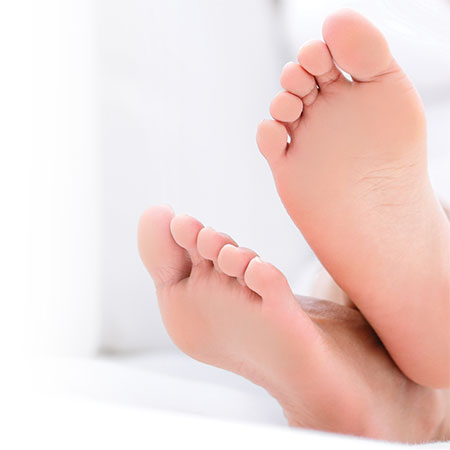Your feet are undeniably your simplest and safest mode of transportation. They provide you with support and freedom; so, provide them with the gift of health!
Feet first
In your daily life, you may not always place a lot of emphasis on foot care. Yet, your feet follow your pace and serve you well in many ways. Did you know that your feet are subjected to a number of “stressors” and must take on countless challenges?
This is why you should pamper your feet. Your occupational and sports activities, choice of footwear, and foot hygiene are among the many factors that influence foot health. In order to remain “on the ball”, your feet need to be pampered a little.
Here are a few tips about foot care:
- Maintain excellent hygiene.
- Use a gentle soap, rinse your feet well after washing them, and dry them before putting on your socks.
- Apply quality moisturizer before going to bed.
- Trim your nails regularly, but don’t cut them too short to prevent ingrown toenails.
- Wear well-fitting shoes.
- Do not wear high heels every day. They are bad for your feet and for several other parts of your body.
- Examine your feet regularly to quickly detect any problems, lesions or changes in appearance. Use a compact mirror if needed.
- Never ignore a foot problem; seek medical attention promptly.
Foot health issues
Each pair of feet is unique and can have its share of small or big problems. Here are some of the most common ones:
Athfoot’ste’s foot.
This is a very common fungal infection that affects the feet’s skin (especially the toes). It can be caused by different factors, such as heat and humidity. Oftentimes, cracked skin, and in some cases, whitening of the skin between the toes can be observed. Many people will suffer from it in the course of their lifetime, men more frequently than women.
Plantar wart.
This consists of a small greyish lesion, most often appearing on the soles of the feet. It can sometimes be painful. Although it is more common in children, anyone can have it at one time or another. Although it can be difficult to get rid of, it sometimes disappears on its own, but it is often preferable to treat it to relieve pain and prevent it from spreading (because it is caused by a virus, it is highly contagious).
Blister.
A blister is most often the result of a wound or from the skin rubbing on a shoe and looks like a whitish bubble, which should not be popped, because it protects the skin. A popped blister becomes a lesion which must be cared for like a minor wound to promote healing and prevent infection.
Corn and callus.
Corn and calluses are parts of the foot’s skin that are hard and thick in areas where there was friction or pressure, most often due to ill-fitting footwear. As a result, the skin develops a defense mechanism meant to protect against potential future wounds. A corn is generally smaller and more painful than a callus.
Bunion.
A bunion is a foot deformity (swelling) of the joint located at the base of the big toe. The cause may be explained by different factors, including wearing high heels or tight-fitting, narrow or pointy-toed shoes. Heredity is also a factor. The size and severity of the bunion varies. In the most serious cases, surgery may be necessary. However, many people find relief by wearing flexible shoes and by using arch supports.
You can find a wide range of products for the prevention and treatment of foot issues at the pharmacy, as well as various items designed to improve comfort for people with these types of issues. Speak to your pharmacist for information and advice.
The foot health specialist is called a podiatrist. It may be beneficial to consult a specialist if you experience foot health issues. The podiatrist can make a diagnosis and suggest corrective measures. A number of effective treatments can be provided or recommended by this specialist.
Since you likely have many more roads to travel, make sure you can count on healthy feet. Don’t hesitate to speak to a healthcare professional such as your pharmacist!


